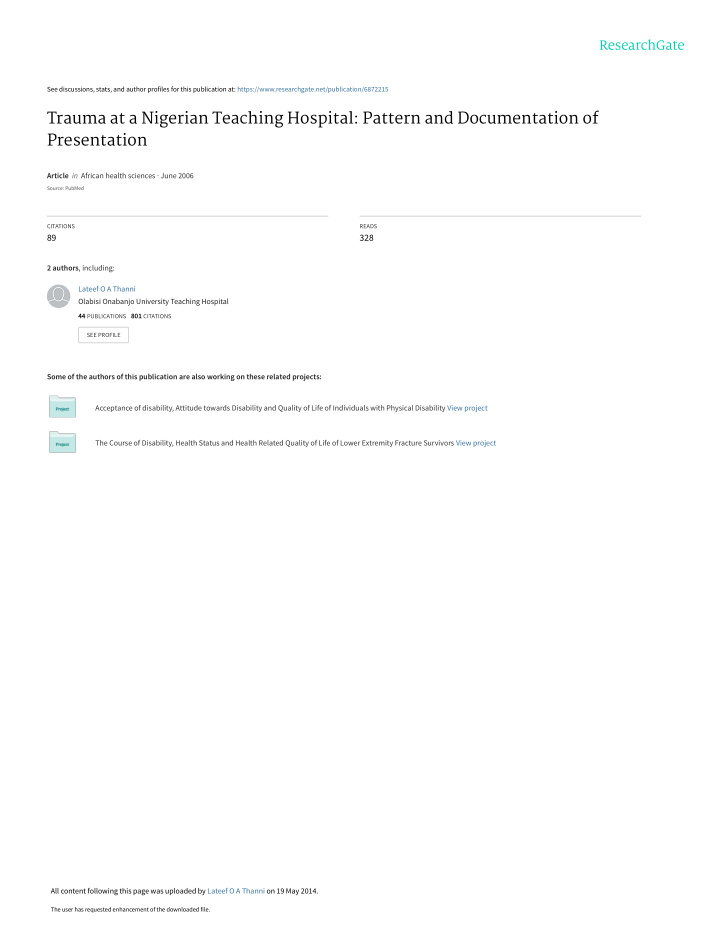



See discussions, stats, and author profiles for this publication at: https://www.researchgate.net/publication/6872215 Trauma at a Nigerian Teaching Hospital: Pattern and Documentation of Presentation Article in African health sciences · June 2006 Source: PubMed CITATIONS READS 89 328 2 authors , including: Lateef O A Thanni Olabisi Onabanjo University Teaching Hospital 44 PUBLICATIONS 801 CITATIONS SEE PROFILE Some of the authors of this publication are also working on these related projects: Acceptance of disability, Attitude towards Disability and Quality of Life of Individuals with Physical Disability View project The Course of Disability, Health Status and Health Related Quality of Life of Lower Extremity Fracture Survivors View project All content following this page was uploaded by Lateef O A Thanni on 19 May 2014. The user has requested enhancement of the downloaded file.
Trauma at a Nigerian teaching hospital: pattern and docu- mentation of presentation L.O.A. Thanni 1 O.A. Kehinde 2 1. Dept of Orthopaedics & Traumatology, College of Health Sciences, Olabisi Onabanjo University, Sagamu, Ogun State, Nigeria. 2. Dept of Surgery, Olabisi Onabanjo University Teaching Hospital, Sagamu, Ogun State, Nigeria. Summary Background and Objectives : This study is aimed at identifying the characteristics of injuries and determining the efficiency of documentation of patients’ records in a tertiary hospital where there is no trauma registry. Patients and Methods : A retrospective case record analysis was conducted of injured patients seen at the Accident and Emergency unit over a 12 month period from January to December 2003. Results : A total of 1078 records of injured patients that attended the A&E were analysed. Their mean age was 31years (range 3 months to 85 years). Laceration (n = 408) and fractures (n = 266) representing 62.5% of injuries were seen. Injuries to the lower limb occurred in 239 patients, multiple anatomical sites 224, head 224, upper limb 203, the neck 20, and the abdomen 11 patients. Trauma was due to road traffic accident in 977 patients, fall in 39, assault in 14 while burns and firearm injuries occurred in 5 and 7 patients respectively. The mean injury severity score (ISS) was 4. Severe injuries, ISS > 15 occurred in 54 patients with mean ISS of 21, and resulted from RTA in 92.6% of cases. Mortality from severe injuries occurred in 31.5% of cases while overall mortality was 2%. Most deaths were associated with multiple injuries (60.9%) and head injury (30.4%). Incomplete documentation of accident and injury data occurred frequently, from 2% of some data to 100% of others. Conclusions : Lacerations and fractures were the most common injuries. Mortality is due usually to head and multiple injuries. Research into appropriate strategies for prevention of injuries, especially RTA, is required but this must start with the establishment of institutional and regional trauma registries for complete documentation of relevant data. Key words : trauma; injury; road traffic accident; mortality; injury severity score, pidemiology. African Health Sciences 2006; 6(2): 104-107 towards reducing this epidemic. According to the WHO, Introduction worldwide each year, 1.2 million people are killed and Trauma care research in Nigeria is still in the 50 million are injured in road traffic accidents. The cost developmental stages with relatively few published data. to low income countries is approximately 1% of their There are no trauma registries, thus making documenta- gross national product, more than the total development tion of injuries inadequate and accessing these data aid received by these countries 3 . problematic. However, road traffic injuries have been Road traffic injuries are ranked ninth among global shown to be the most frequently encountered injuries causes of disability-adjusted life years lost and developing seen in hospitals while population based studies are non countries account for over 80% of deaths globally due existent 1, 2 . Apart from funding, specific limitations to to road traffic accidents 3 . The morbidity and mortality trauma research have not been documented. burden in developing countries is rising due to a The World Health Organisation’s World Health Day combination of factors, including rapid motorisation, for 2004 was dedicated to road safety. This level of atten- poor road and traffic infrastructure as well as the tion to road safety underscores the global burden of road behaviour of road users 4 . This contrasts with traffic injuries and the need for public health concern technologically advanced countries where the indices are reducing 5, 6 . Correspondence: Effective policies on road safety can only be developed L.O.A. Thanni. when based on the evidence of local research and designed Dept of Orthopaedics and Traumatology for target demographic, economic and political College of Health Sciences environments. Successful interventions in developed Olabisi Onabanjo University, P .M.B. 2022 Sagamu countries cannot simply be adopted but rather adapted Ogun State, NIGERIA because of differences in the behaviour of road users, E-mail: loathanni@yahoo.com quality of vehicles and the environment 4, 7 . Adaptation African Health Sciences Vol 6 No 2 June 2006 104
Recommend
More recommend